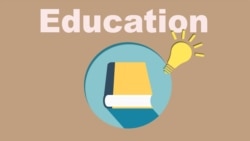In a town near Indianapolis, Indiana, 19-year-old college student Grace Kern has been working in elementary school classrooms. She is helping students as teachers offer instruction online via a screen inside the room.
"My dad told me that a bunch of teachers are out and they're struggling to get substitutes in. And I was like, 'Well, all my classes are online, except for one, so I have the time to do it.' And I would hate for the schools and the students to struggle," she said. Grace Kern is studying medical imaging technology at Indiana University – Purdue University Indianapolis.
Her father is Scott Kern, a human resources director at Greenfield-Central Community Schools. He asked the community for help as he watched the number of substitute teachers go down.
"I said, 'If you've got a student who's in college, maybe they'd like to work even a two-month thing for us - which would be a stopgap, no doubt - but it will help us a whole, whole bunch."
More than 12 college students answered the call including Kern’s own daughter.
More teachers needed
As the coronavirus makes large numbers of educators stay at home or stop working, school districts around the country are aggressively employing substitute teachers. The schools offer extra money and do not require the employees to have a teaching degree. They are doing all they can to keep classrooms open.
Coming to the rescue in many cases are college students who are themselves learning online or home for long winter breaks.
Before the pandemic hit, there was already a shortage of teachers. Fewer students became teachers and retired teachers were staying home with health concerns. Teachers now are staying home because of contact tracing or exposure to the virus. This situation has made schools move to distance learning even when they could have in-person classes.
Governor Ned Lamont is the Democratic leader of the state of Connecticut. Late last month, he asked college students who were coming home for their winter break to help in hospitals, virus testing sites – and in schools. In cases where teachers are leading instruction from a distance, Lamont said college students could be paid to come into the classrooms and help provide supervision.
"Look, you could binge watch Netflix for three weeks, but we have some other ways that you could really be of assistance, helping your entire community get through this pandemic," Lamont said at a news conference.
Isabel Orozco is a freshman at Wellesley College. She is working as a substitute teacher in the Cheshire, Connecticut district, where she graduated high school in June. She said she's considering taking all of her spring term classes online, so she can continue working in the public schools.
"Anything I can do to help, I feel good about," she said.
Ongoing teacher shortage
The temporary employer Kelly Education works with districts to provide substitutes. Company president Nicola Soares said the pandemic has exposed problems with shortages that have been worsening for years. Soares said the past ten months have quickly made it worse, adding that she does not expect too much improvement next school year. "We have seen a lot of folks leave the profession. The openings are going to increase, so it is [a] domino effect," she said.
In South Carolina, Lisa Usry, of Charleston, experienced this herself. One of her first jobs of the year was substituting for a teacher in his mid-60s who quit suddenly.
"He worked a couple of weeks and said, 'I'm out of here' and walked out the door," she remembered.
Lower requirements
In Nebraska, more school organizations are asking the state government to excuse substitutes from a requirement to have a teaching certificate. That change lets administrators hire substitutes who have 60 college credits. The student must have completed a teaching class and another that deals with unfair treatment and discrimination.
In Iowa, more substitute jobs are going unfilled, even after the state lowered its requirements. Coy Marquardt is associate executive director at the Iowa State Education Association. He explained that in the past, schools could divide a missing teacher's students among the other teachers in the building. But that will not work in a pandemic, he said.
To deal with the teacher shortage, some administrators and counselors are serving as substitutes, although even that is not enough.
"That is one of the reasons why some of the districts went and are still in virtual or remote because they just didn't have the staffing," Marquardt said.
I’m Jill Robbins.
Heather Hollingsworth and Casey Smith wrote this story for the Associated Press. Jill Robbins adapted it for Learning English. Mario Ritter, Jr. was the editor.
_______________________________________________
Words in This Story
stopgap - n. someone or something that is intended to be used for a short time and then replaced by someone or something better; a temporary substitute
bunch - n. chiefly US, somewhat informal. a large amount
contact tracing - n. Tracers work with confirmed COVID-19 patients to learn whom they have been close to. The tracers then inform those people that they may have been infected. The tracers also provide advice on what actions to take.
binge – n. a short period of time when you do too much of something
expose – v. to reveal or show something that was hidden
domino effect – n. a chain reaction produced when one event sets off a chain of similar events
a couple (of) –n. two or several of something
certificate –n. a document that proves you have finished training from a school or organization
virtual –adj. existing on computers or online, not physical
staffing –n. employees
Is there a problem finding teachers to work where you live? We want to hear from you. Write to us in the Comments Section.












